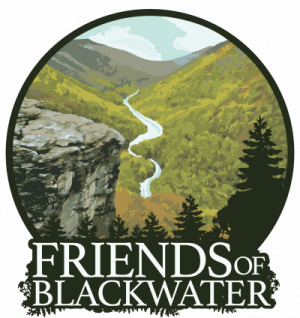
Angiospermae
(Class)
Flowering Trees & Shrubs
Trees
Yellow Birch
Betula alleghaniensis
One of the dominant deciduous components of our northern-type hardwood forests is the yellow birch which has its name derived from the yellowish that in mature specimens, flakes off in thin layers, giving it a papery appearance. A closer approach of the trunk will give way to scattered holes. These holes are known as lenticels which permit the exchange of gases between the environment and the internal tissue spaces of the organs, with birches the trunk.
Like other birches, the growth of the twigs grows in an alternating manner that gives the twigs a “zig-zagging” look as they reach their tips. Leaves are ovoid-shaped with a finely serrated margin and turn yellowish in the fall adding to the great fall foliage that you can immerse yourself in here around the Blackwater watershed. Look for this species in rich woodlands and can occur throughout the watershed, for example along the “Yellow Birch Trail” at Blackwater Falls State Park. Twigs from smaller trees can be snapped off and chewed up for a tasty treat that tastes and smells of wintergreen or root beer while on the trail.
Quaking Aspen
Populus tremuloides
The Blackwater River Watershed is one of the Southernmost extents of quaking aspen’s range on the East Coast. Deemed “quaking” due to the trembling of its leaves upon the smallest breeze. One of the last trees to change color in the fall, quaking aspen leaves can be seen exhibiting a striking yellow color which looks even more beautiful against its bright white bark. This tree is unique in that it spreads laterally across the landscape via its root network, popping up clones as it expands.
Acer rubrum
Red Maple
Red maple is a very common tree in the Blackwater River Watershed. The leaves vary quite a bit during the fall, exhibiting colors of deep red all the way to bright yellow. The color of the leaves depend on the pH and drainage of the soil of that specific tree.
Acer saccharum
Sugar Maple
Sugar maple is widely regarded as one of the most beautiful fall trees. They exhibit a bright yellow-orange color that’s easy to spot from afar. This is the tree used in the production of maple syrup!
Shrubs
Giant Rhododendron
Rhododendron maximum
Rhododendron is a dominant component of the understory on the moist, shaded slopes of the Blackwater Canyon. An evergreen shrub or small tree, the Giant Rhododendron can create thickets in the understory famously known for how dense they can grow, and limit travel as noted by some of the first explorers to the Canyon. They retain their large, alternate, dark green and leathery leaves throughout the year, only dropping older leaves occasionally. Leaves show drooping and curling that are typical in low winter temperatures. Look for this species blooming from June-August where they display umbel-like inflorescences that are pink to whitish. The flowers are iconic in West Virginia, being displayed by the West Virginia State Parks emblem as it is the state flower of West Virginia.
Common Ninebark
Physocarpus opulifolius
A shrub that can be commonly found lining the riparian corridor of the Blackwater River as it flows through downtown Thomas, Common Ninebark can be recognized as a shrub that grows three to nine feet tall with leaves superficially similar to maple leaves with their three-lobed structure. Along the stem and branches the bark peels off in numerous thin layers as it matures and is where its name is derived from. Look for this shrub to be flowering along the river from May to June, with flowers being whitish to purplish. The flowers give way to a fruit that is an inflated seed capsule (a follicle) for each flower, borne in the upright cluster, turning to a reddish brown in the fall and by that time the cluster is usually drooping. This cluster often persists through the winter and can be a key aid to identifying this species once it has dropped its leaves.










